The soft hackle is supposed to be - as the name implies - soft. Soft hackle can come from many birds. Chickens, gamebirds like partridge, grouse and quail, pheasant and even crows and jackdaws.
Soft hackle is very different from dry fly hackle. The soft hackle is supposed to be - as the name implies - soft, unlike the dry fly hackle which should be stiff and support the dry fly as it rides on the surface film.
The soft hackle can come from many birds. Chickens are still the most common, but other well known soft hackling materials are from gamebirds like grouse, quail and especially partridge, which is widely used on soft hackled flies like spiders and flymphs, but also starling and even pheasant feathers are used as soft hackles, and Guinea fowl is a common soft hackle on salmon and sea trout flies. Other soft hackle feathers can be found. Birds like crow and jackdaw also contain lots of useful and soft fathers in natural black and gray colors, and are occasionally seen in shops and on flies, even though they aren't that common.
The applications are quite varied from tying spiders and flymphs with a few, sparse hackle fibers to large flies such as salmon and steelhead flies requiring many turns of hackle as a dense body or front hackle.
I will cover marabou used as a hackle in a separate article on this material.
No matter what type of softhackle flies you are tying, you want dense and soft barbs, which appear dull and velvet-like. Like on dry fly hackle you want thin stems, no growth marks, no broken barbs, no molting feathers and no dirt or grease.
When we're talking chickens you can select from hen or rooster, and both hen saddles and necks are usually fine, while it's often the saddles that are good on the rooster, because the barbs on the rooster necks tend to be stiffer, shinier with fewer barbules. You can read more about selecting rooster saddles for applications like saltwater and pike flies flies in a separate article in this series.
Using soft hackle
Soft hackle feathers are excellent for several purposes:
Soft, wrapped hackle where the barbs will move gently in the water without the stiffness typical for rooster hackle. The hackle can be very sparse as on spiders and flymphs or denser as is the case on certain nymphs and many wet flies and even very dense as it's often used on salmon and steelhead flies or saltwater flies.
False hackles where a bunch of barbs sit under the front of the fly. This can be obtained either by hackling as usual and stroking down the barbs or by simply tying in a bunch of cut-off barbs under the hook shank and letting them fan out slightly.
Wet fly wings - both whole feathers and made from married or bundled barbs. A lot of really classic wet fly patterns use whole feathers mounted vertically while others use the more common style of marrying barbs to form a typical wet fly feather wing.
A special use of soft hackle in wings is the matuka style, where whole feathers are tied in as wings along the top of the hook shank.
Dry fly wings. On dry flies the barbs are sometimes rolled to form a vertical wing and at other times the tips of the feathers are tied in as fan wings, back to back, creating amazingly natural looking wings for flies such as mayflies.
Used in tails where the feather can be tied in as very controlled, married strips or as a simple, rolled bunch of barbs.
For all these purposes you utilize the visual density of the hen feathers and/or their softness.
When buying hen feathers
You can get some beautiful and quite inexpensive feathers by buying hen necks and saddles or whole skins. Hen feathers are usually shorter and rounder than rooster feathers and almost always softer and less shiny.
As always: Get the feathers out of the bag and run your fingers through them. Make sure that the barbs can separate properly when you wrap them if you want hackle or that they marry willingly if your aim is married wings and tails. Some soft feathers have a remarkable tendency to marry and stick together and can be hard to get to spread out nicely when used as hackle. If you are going to use the feathers for full feather wings or posted wings on dry flies, it can on the other hand be an advantage that the barbs marry willingly.
Make sure the stems are thin and soft without being fragile. Some hen feathers have a very short, useful part, and if your are going to use them as a wrapped hackle, you might want to make sure you get the longest possible feathers.
Also note the length of the barbs. It can vary on the individual skins and even on the individual feathers, which can be tapered leaving you with very short barbs in the tip of the feather. Other skins and feathers are more consistent. Measure the barb length by wrapping some feathers around a hook shank or a piece of wire or simply splitting the barbs with your fingers. Make sure the barb length matches your needs.
Going through natural hen feathers can reveal a whole adventure in discrete black, brown, tan and gray patterns with contrasting edges, mottling, center stripes and many more variations. Each animal has its own pattern, and mottled brown isn't just mottled brown.
Dyed feathers are also widely available, and the color selection is steadily growing these years, as demands from especially contemporary salmon fly tyers grow. The dyed feathers are mostly of good quality and with consistent color, but as always with dyed material you should make sure that the surplus dye has been rinsed out and that the feathers haven't been damaged in the dying process.
Gamebird skins
The gamebird feathers are usually bought on the whole skin. You can get bags of feathers, but they are often of such bad and inconsistent quality that it's close to a waste of money. The skins might seem expensive at first, but in the long run it is the most economical way to buy feathers.
Make sure you get nicely prepared skins that are presented even and flat, and not folded into a narrow bag. Get the skin out and make sure the feathers are whole, clean and useful for your purpose. Don't get fooled by large and gaudy looking skins, because if you are tying smaller flies like nymphs and spiders, you will need small feathers.
Look at the stem length and taper. The gamebirds mostly have very short feathers with thick stems at the base and thin stems at the tips. Skins with longer feathers and even thickness stems can be preferable.
Keep your eyes out for dyed gamebird skins, which can be very beautiful and useful. You can find both "natural" colors such as black, olive and brownish hues as well as more vivid colors like orange, red, green, blue and purple.
Gamebirds often come from remote parts of the world, and can be chemically treated to avoid bug attacks during long transport and storage. Simply smell the skin. A strong chemical odor should make you inspect the skin extra carefully for flaws. The best prepared skins smell soapy or not at all. If the skin looks good, but smells, you can buy it and wash out the smell once you are home.
One way to avoid the worst quality is to buy skins from farmed birds. Such skins are sometimes available from different pheasants, guinea fowls and other birds while the partridge, grouse and quail skins are normally from wild birds.
Articles about hen feathers
Videos about hen feathers
- Log in to post comments



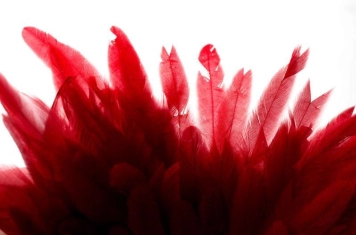



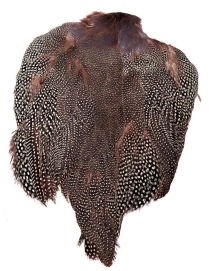

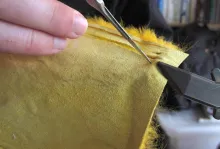



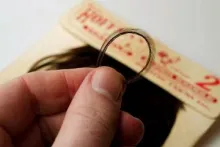






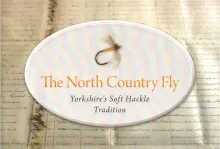


Any size soft hackle
I began a few years ago to tie small soft hackles in the 16 to 20 size range. Feathers are few and far between on the partridge skins to reach that size hook.
I stumbled on to a video on You Tube, I believe from the Blue Ribbon Fly Shop that showed how to use any size
soft hackle feather and create a soft hackle for the fly. In essence, the trick is to cut the stem and form a V in the feather. Using that notch in the feather, spin the available feather herl like you would deer hair in a single action that creates the soft hackle wrap.
Very educational and very easy to do. Matched with your content on how to use and select feathers, anyone could tie any size soft hackle.
There`s one more info
There`s one more information about buying soft hackles. Of course you can buy by luck very good and not too expensive hen or game bird skins in the local shop`s, but a very, very good idea is to contact "Chevron Hackles" in the UK. I never tied with better hackles! Especially the coloured skins are absolut perfeckt for seatrout- and stillwater flies. Check them out!
Tight lines!
URL for Clint Brumitt's tip to use any size hackle
I found this to be one of the best tying tips I have ever seen...
https://www.youtube.com/watch?v=31DWumnrPIs